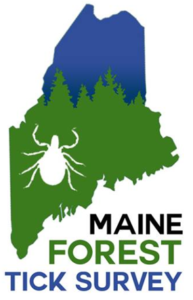How Do Forest Management Practices Affect Ticks and Disease? Forest Tick Survey Launches Citizen Science Project to Learn More, Inform Landowners
 As ticks are on the rise in Maine, a UMaine project is investigating how to better protect Maine’s landowners, forest workers, and recreationists from tick-borne diseases. The Maine Forest Tick Survey is a multi-year, citizen-science project researching how forest management practices, such as if and when timber is harvested, affect the incidence of ticks and tick-borne disease.
As ticks are on the rise in Maine, a UMaine project is investigating how to better protect Maine’s landowners, forest workers, and recreationists from tick-borne diseases. The Maine Forest Tick Survey is a multi-year, citizen-science project researching how forest management practices, such as if and when timber is harvested, affect the incidence of ticks and tick-borne disease.
Volunteers who own properties of 10 to 1,000 acres of forested land in Maine’s southern and coastal counties are encouraged to participate. Through the project, landowners will gain access to data on the incidence of ticks and disease pathogens on their land, and information on potential strategies for mitigating risks from tick-borne disease. Landowners will conduct surveys and collect ticks on their own property in July 2020. Ticks will be identified and tested for pathogens at UMaine and results will be available beginning in spring 2021.
In light of the COVID-19 crisis, researchers have adapted protocols so volunteer education and training can be done online or remotely.
The project is led by Elissa Ballman, research associate in the School of Biology and Ecology, and UMaine faculty Allison Gardner, Carly Sponarski (both Mitchell Center faculty fellows), and Jessica Leahy.
Learn more at the Survey’s Facebook page and website, and contact Elissa Ballman with any questions.
